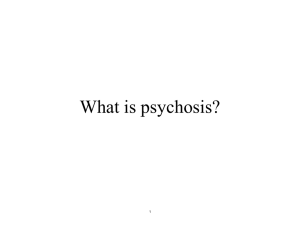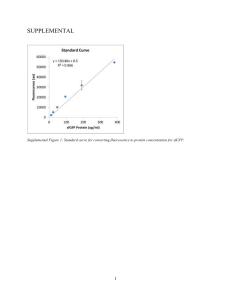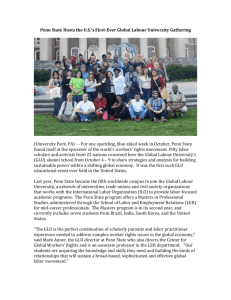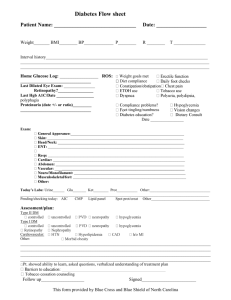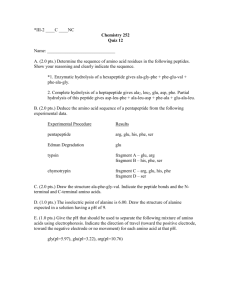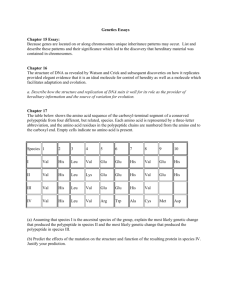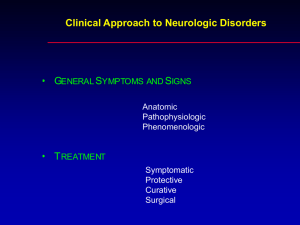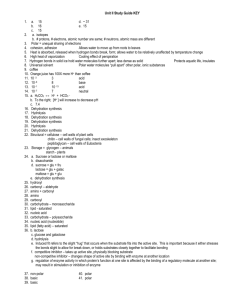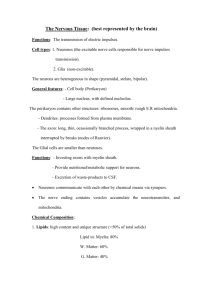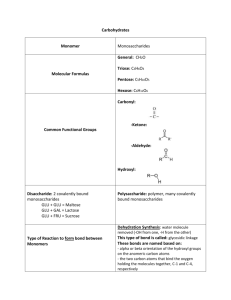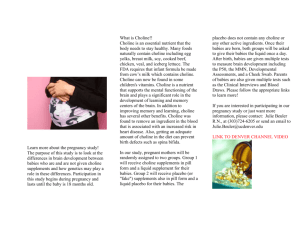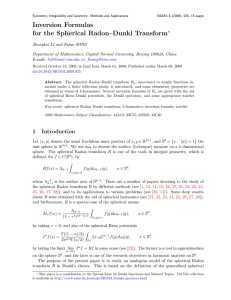Metabolism of neurotransmitters
advertisement
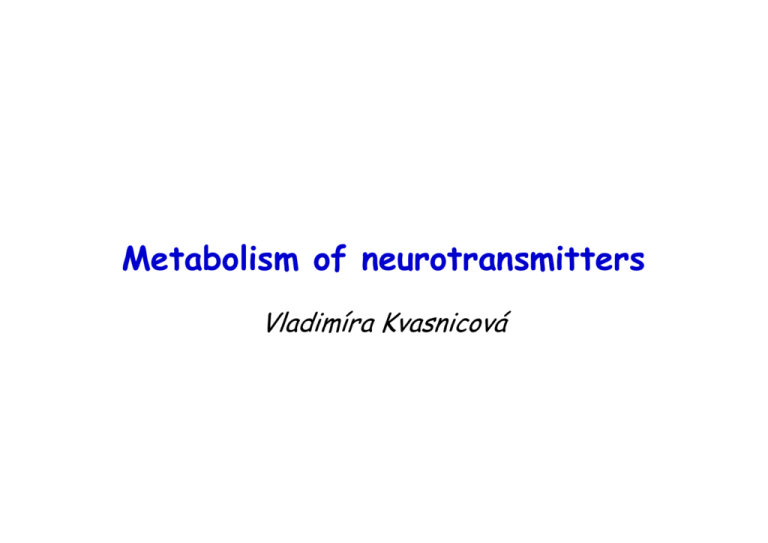
Metabolism of neurotransmitters Vladimíra Kvasnicová exam questions: 4, 25-28, 31-33, 38 J.Koolman, K.H.Röhm / Color Atlas of Biochemistry, 2nd edition, Thieme 2005 J.Koolman, K.H.Röhm / Color Atlas of Biochemistry, 2nd edition, Thieme 2005 1-2) voltage-gated Na+_channels depolariztion 3-4) voltage-gated K+_channels hyperpolariztion Na+/K+-ATPase → return to the rest state J.Koolman, K.H.Röhm / Color Atlas of Biochemistry, 2nd edition, Thieme 2005 Overview of neurotransmitters 1. amino acids excitatory: glutamate, aspartate inhibitory: GABA (γ-aminobutyric acid), glycine 2. biogenic amines (monoamines) catecholamines: dopamine and noradrenaline serotonin, histamine acetylcholine (quarternary ammonium cation) 3. peptides endogenous opioids: endorphins, enkephalins, dynorphins 4. other adenosine, anandamide, NO,... Glutamate and GABA synthesis (starts in astrocytes, Gln is then transported to neurons) substrate: α-ketoglutarate (α-ketoGlt, Krebs cycle intermediate) a) transamination to Glu (α-ketoGlt + any amino acid → Glu + α-ketoacid; specific aminotransferase, PALP = pyridoxalphosphate) or b) reductive amination to Glu (α-ketoGlt + NH3 + NADPH+H+ → Glu + NADP+, glutamate dehydrogenase) c) amidation of Glu (Glu + NH3 + ATP → Gln + ADP + Pi, glutamine synthetase) d) decarboxylation of Glu to GABA (Gln → Glu; glutaminase; Glu → CO2 + GABA; PALP, glutamate decarboxylase) degradation (Glu and GABA taken from synapses by astrocytes): transamination: Glu → α-ketoGlt → Krebs cycle (KC) GABA → succinate semialdehyde → succinate → KC (transamination) (dehydrogenation = oxidation) Obrázek převzat z učebnice: J.Koolman, K.H.Röhm / Color Atlas of Biochemistry, 2nd edition, Thieme 2005 GABA - shunt Krebs cycle succinate oxidation 2-oxoglutarate succinyl-CoA succinate semialdehyde decarboxylation transamination glutamate Formation of Glu and Asp from Krebs cycle intermediates: α-ketoglutarate and oxaloacetate alanine aminotransferase (ALT = GPT) aspartate aminotransferase (AST = GOT) Devlin, T. M. (editor): Textbook of Biochemistry with Clinical Correlations, 4th ed. Wiley-Liss, Inc., New York, 1997. ISBN 0-471-15451-2 Aspartate and Glycine synthesis Asp by transamination of oxaloacetate (Krebs cycle intermediate): oxaloacetate + Glu → Asp + α-ketoGlt, aspartate aminotransferase, enzyme: AST Gly from serine: Ser + THF → Gly + methylene-THF + H2O (Ser can be synthesized from 3-phosphoglycerate = intermediate of glycolysis) degradation (reverse reactions of the synthesis) Asp by transamination to oxaloacetate (enzyme: AST) Gly conversion to Ser, which can be degraded to pyruvate glycolysis Glycine synthesis from http://www.biocarta.com/pathfiles/GlycinePathway.asp (Jan 2007) Synthesis of catecholamines substrate: tyrosine (= 4-hydroxyphenylalanine) can be synthesized from Phe (essential amino acid) by hydroxylation (phenylalanine hydroxylase, tetrahydrobiopterin = THB); DOPA = 3,4-dihydroxyphenylalanine Degradation of catecholamines enzymes: MAO and COMT http://www.cvpharmacology.com/norepinephrine.htm Degradation: monoamine oxidase CHO catechol-O-methyl transferase http://physrev.physiology.org/content/89/2/535 CHO Synthesis of serotonin THB PALP THB = tetrahydrobiopterin (cofactor of Trp-hydroxylase) PALP = pyridoxalphosphate (cofactor of decarboxylase) http://brainyinfo.com/neurotransmitters/neurotransmitter-serotonin/ Degradation of serotonin 5-hydroxyindole acetic acid (5-HIAA) http://www.pharmacorama.com/en/Sections/Serotonin_2_1.php Histamine synthesis degradation: histamine-N-methyl transferase (N-methylation by S-adenosine methionine = SAM) -CH3 adopted from http://www.sbuniv.edu/~ggray/CHE3364/b1c25out.html Synthesis of acetylcholine: serine ethanolamine by acetylation of choline (acetyl-CoA + choline) choline can be a) synthesized from serine: acetylcholine choline decarboxylation to ethanolamine and methylation by SAM to choline or b) released from the phospholipid lecithine (= phosphatidylcholine) by phospholipase Degradation: by acetylcholine esterase (in synaptic cleft) to choline and acetate, choline then undergoes re-uptake http://quizlet.com/5858500/module-1-cholinergics-and-anticholinergics-flash-cards/ http://web.campbell.edu/faculty/nemecz/323_lect/Nitrogen_metabolism/images/choline.jpg Obrázek převzat z učebnice: J.Koolman, K.H.Röhm / Color Atlas of Biochemistry, 2nd edition, Thieme 2005 Endogenous opioids are neuropeptides synthesized from larger precursor polypeptides by alternative hydrolysis endorphins: from proopiomelanocortin (POMC) → β-endorphin (31 amino acids) enkephalins: from proopiomelanocortin or proenkephalin or * → met-enkephalin, leu-enkephalin (pentapeptides) dynorphins: from prodynorphin * → dynorphin A, dynorphin B, neoendorphin nociceptin (= orphanin FQ; 17 amino acids): from pronociceptin https://www.glowm.com/resources/glowm/cd/pages/v5/v5c010.html
